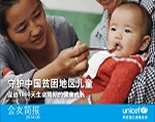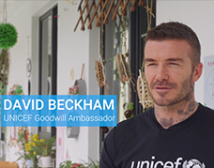NEW YORK, 1 November 2017——Staggering numbers of children – some as young as 12 months old – are experiencing violence, often by those entrusted to take care of them, UNICEF said in a new report released today.
“The harm inflicted on children around the world is truly worrying,” said UNICEF Chief of Child Protection Cornelius Williams. “Babies slapped in the face; girls and boys forced into sexual acts; adolescents murdered in their communities – violence against children spares no one and knows no boundaries.”
|

©UNICEF/UN018674/Zehbrauskas
On 14 April 2016, Patricia, 14, covers her face in a school in Soyapango municipality in the San Salvador, Department of El Salvador. |
A Familiar Face: Violence in the lives of children and adolescentsuses the very latest data to show that children experience violence across all stages of childhood and in all settings:
Violence against young children in their homes:
-
Three-quarters of the world's 2- to 4-year-old children – around 300 million – experience psychological aggression and/or physical punishment by their caregivers at home;
-
Around 6 in 10 one year olds in 30 countries with available data are subjected to violent discipline on a regular basis. Nearly a quarter of one-year-olds are physically shaken as punishment and nearly 1 in 10 are hit or slapped on the face, head or ears.
-
Worldwide, 1 in 4 children under age five – 176 million – are living with a mother who is a victim of intimate partner violence.
Sexual violence against girls and boys:
-
Worldwide, around 15 million adolescent girls aged 15 to 19 have experienced forced sexual intercourse or other forced sexual acts in their lifetime.
-
Only 1 per cent of adolescent girls who had experienced sexual violence said they reached out for professional help.
-
In the 28 countries with data, 90 per cent of adolescent girls who had experienced forced sex, on average, said the perpetrator of the first incident was known to them. Data from six countries reveals friends, classmates and partners were among the most frequently cited perpetrators of sexual violence against adolescent boys.
|

©UNICEF/UN015618/Prinsloo
On 21 March 2016, Gina, 12, embraces her mother in the backyard of their home on the island of Nosy Be, off the northwest coast of Madagascar. |
Violent deaths among adolescents:
-
Globally, every 7 minutes an adolescent is killed by an act of violence.
-
In the United States, non-Hispanic black boys aged 10 to 19 years old are almost 19 times more likely to be murdered than non-Hispanic white boys of the same age. If the homicide rate among non-Hispanic black adolescent boys is applied nationwide, the United States would be one of the top ten most deadly countries in the world.
-
• In 2015, the risk of being killed by homicide for a non-Hispanic black adolescent boy in the United States was the same as the risk of being killed due to collective violence for an adolescent boy living in war-torn South Sudan.
-
• Latin America and the Caribbean is the only region where adolescent homicide rates have increased; nearly half of all homicides among adolescents globally occurred in this region in 2015.
Violence in schools:
-
Half the population of school-age children – 732 million – live in countries where corporal punishment at school is not fully prohibited.
-
Three-quarters of documented school shootings that have taken place over the past 25 years occurred in the United States.
|

©UNICEF/UN076694/Amaya
Javier, 10, attends the UNICEF-supported Carlos Alberto Rivera Hernandez School in San Pedro Sula, Cortes, Honduras, Friday 8 April 2016. |
UNICEF prioritises efforts to end violence across all its work, including supporting government efforts to improve services for children affected by violence, developing policies and legislation that protect children, and helping communities, parents and children to prevent violence through practical programmes like parenting courses and actions against domestic violence.
To end violence against children, UNICEF is calling for governments to take urgent action and support the INSPIRE guidance which has been agreed and promoted by WHO, UNICEF and the Global Partnership to End Violence Against Children, including:
-
Adopting well-coordinated national action plans to end violence against children – incorporating education, social welfare, justice and health systems, as well as communities and children themselves.
-
Changing behaviours of adults and addressing factors that contribute to violence against children, including economic and social inequities, social and cultural norms that condone violence, inadequate policies and legislation, insufficient services for victims, and limited investments in effective systems to prevent and respond to violence.
-
Focussing national policies on minimizing violent behaviour, reducing inequalities, and limiting access to firearms and other weapons.
-
Building social service systems and training social workers to provide referrals, counselling and therapeutic services for children who have experienced violence.
-
Educating children, parents, teachers, and community members to recognise violence in all its many forms and empowering them to speak out and report violence safely.
-
Collecting better disaggregated data on violence against children and tracking progress through robust monitoring and evaluation.
###
Note to Editors
For more information about the Global Partnership to End Violence Against Children, please go to www.end-violence.org/.
Multimedia content is available here.
About UNICEF
UNICEF works in some of the world's toughest places, to reach the world's most disadvantaged children. Across 190 countries and territories, we work for every child, everywhere, to build a better world for everyone. For more information about UNICEF and its work for children visit www.unicef.org.
For more information, please contact:
Georgina Thompson, UNICEF New York, Mobile: + 1 917 238 1559, gthompson@unicef.org
































